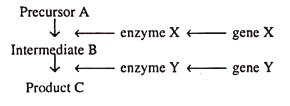The following points highlight the two main kinds of mycelia in fungi. The kinds are: 1. Aseptate Mycelium 2. Septate Mycelium.
Kind # 1. Aseptate Mycelium (Fig. 1.2):
In the algal fungi (Phycomycetes) the mycelium in the vegetative phase usually lacks internal partitions of any kind. The hyphae are thus multinucleate and aseptate. The mycelium is a continuous mass. It grows terminally by the apical elongation of the hyphae accompanied by increase in the number of nuclei by nuclear divisions.
The aseptate, multinucleate mycelium is called coenocytic. The septa in the aseptate, coenocytic mycelium, however, are formed only to cut off reproductive structures, or to seal off a damaged portion. Such septa are solid plates. They lack pores.
Kind # 2. Septate Mycelium (Fig. 1.3):
The members of other classes of fungi (Ascomycetes and Basidiomycetes) develop internal cross walls called the septa which divide the hyphae into segments. The septa appear at regular intervals behind the hyphal tip. The segments may be uninucleate (Fig. 1.3) or multinucleate (Fig. 1.4). In a septate mycelium the septa between the cells are transverse. Longitudinal or oblique septa are rare.
The formation of septum is always preceded by the division of nucleus. If the cell has more than one nuclei there is simultaneous division of all the nuclei before wall formation. It must, however, be borne in mind that the septa in the septate mycelium of fungi are incomplete.
Each has a central pore and rarely more than one pore. Through these the cytoplasm, cytoplasmic organelles and even nuclei can regularly pass from one cell to other.
It is evident, therefore, that the distinction between coenocytes and septate hyphae is not so profound as it was formerly thought to be. The presence of septa gives mechanical support to the hyphae. Complete partitions do not occur in the vegetative phase of fungi. In some cases, the septa possess more than one pore and rarely none at all.
Origin of Septa (Fig. 1.5):
The septa in all the fungi (septate Phycomycetes, Ascomycetes, Basidiomycetes and Imperfect Fungi) have a similar origin. They arise at regular intervals behind the hyphal tip. The septum originates at the periphery on the inside of tubular hyphal wall as a ring (annular) or rim of wall material.
The annular growth grows slowly inwards towards the centre (centripetally) like an iris diaphragm increasing in width and decreasing the diameter of pore. A cross wall or septum is finally formed which is seldom complete. The centripetal growth of the septum in fungi is rapid.
According to Buller (1933), the aseptate Rhizopus takes 20-25 minutes to completely seal off a damaged portion. The complex dolipore septum in Rhizoctonia (Basidiomycetes) is completed in 10 minutes. Ciboria takes only 6 minutes.
Septal Pore (Fig. 1.6):
Usually a small hole or a pore remains in the centre of the septum (A). The perforated septum gives rigidity to the tubular hypha maintaining, at the same time, the protoplasmic continuity from cell to cell. In all the septate fungi with the exception of the Basidiomycetes, the septum has a simple central pore in the middle of the cross wall (Fig. 1.6).
The septum in some may be slightly swollen where the pore is formed. In the Basidiomycetes (Fig. 1.7), there is further elaboration of the septum to produce a more complex pore named a dolipore (Latin dolium meaning a large jar).
The rim of the central pore, in this case, is swollen and thickened to form a barrel-shaped structure with open ends which are guarded by cap-like covers. The latter in section appears as a round bracket or parenthesis.
The septal pore cap is, therefore, called the parenthesome. The complete septal pore ordinarily permits the movement of cytoplasm, mitochondria and nuclei from cell to cell but under certain conditions the parenthesome may close the passage. The dolipore parenthesome is the hallmark of the Basidiomycetes.





